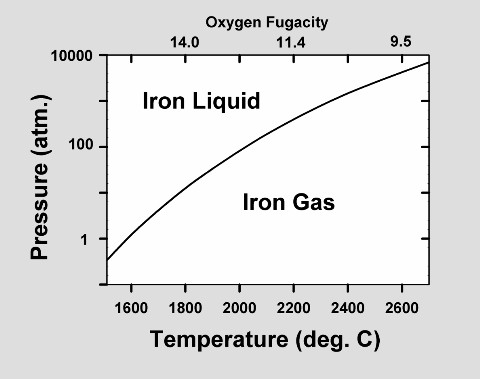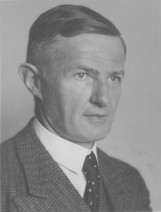 
J. Marvin Herndon's Early Earth Formation as a Jupiter-like Gas Giant |
Various hypotheses about the origin of the Sun and planets, since the 18th Century, generally fall into one of two categories that involve either (1) condensation at high-pressures, hundreds to thousands of atmospheres; or (2) condensation at very low pressures, one ten-thousandth of an atmosphere.
The presently popular idea that Earth formed from matter that condensed at low pressure, one ten-thousandth of an atmosphere began in 1963 as an assumption-based model [1] and was built-upon with other assumption-based models. Basically the idea is this: Dust would condense from the gas, form dust-balls, then grains, then rocks, then planetesimals, and finally planets. But it is not correct. Why? Because such condensation would lead highly oxidized matter which would form planets having insufficiently massive cores [14].

 Thermodynamic
considerations led Arnold Eucken [2], pictured at left, to conceive of Earth
formation at high pressures and high temperatures from within a giant, gaseous
protoplanet with molten-iron first raining out to form the core, then followed
by the condensation of the silicate-rock mantle. Figure at right shows the phase
boundary between liquid iron and a gas of primordial composition in the
range considered by Eucken.
Thermodynamic
considerations led Arnold Eucken [2], pictured at left, to conceive of Earth
formation at high pressures and high temperatures from within a giant, gaseous
protoplanet with molten-iron first raining out to form the core, then followed
by the condensation of the silicate-rock mantle. Figure at right shows the phase
boundary between liquid iron and a gas of primordial composition in the
range considered by Eucken.
J. Marvin Herndon and Hans E. Suess verified those calculations and showed that similar circumstances would explain the oxygen-starved composition of enstatite chondrite meteorite minerals [3]. Herndon subsequently showed that the interior of Earth below a depth of 660 km resembles an enstatite chondrite [4-11]. Later, Herndon extended Eucken's idea to complete condensation of Earth as a Jupiter-like gas giant [12-16]. The discovery of close-to-star gas giant exo-planets lends support to Herndon's idea that Earth originated as as Jupiter-like gas giant.
 Herndon's concept of Earth formation is illustrated at right. Image from
left to right, 1) Earth rains out in the center of a giant
gaseous protoplanet; 2) Fully formed Jupiter-like gas giant
Earth; 3) As the thermonuclear reactions in the Sun ignite,
violent super-intense T-Tauri phase solar winds strip away the gases, leaving;
4) Earth, compressed by about 300 Earth-masses of gas, will
eventually decompress from 64% the diameter of; 5) present-day
Earth; 6) Jupiter is shown for size-scale.
Herndon's concept of Earth formation is illustrated at right. Image from
left to right, 1) Earth rains out in the center of a giant
gaseous protoplanet; 2) Fully formed Jupiter-like gas giant
Earth; 3) As the thermonuclear reactions in the Sun ignite,
violent super-intense T-Tauri phase solar winds strip away the gases, leaving;
4) Earth, compressed by about 300 Earth-masses of gas, will
eventually decompress from 64% the diameter of; 5) present-day
Earth; 6) Jupiter is shown for size-scale.
 Envision
pre-Hadien Earth, compressed to about 64% of its present radius by about 300
Earth-masses of primordial gases and ices. At some point, after being stripped
of its massive volatile envelope, presumably by the Sun's super-intense T-Tauri
solar winds, internal pressures would build eventually cracking the rigid crust.
Powered by the stored energy of protoplanetary compression, Earth's progressive
decompression, illustrated by the image at left, is the principal engine that
drives surface geology. J. Marvin Herndon's new geodynamic theory, called
whole-Earth decompression dynamics [17-19], explains
the myriad measurements and observations whose descriptions are attributed to
plate tectonics, but without requiring physically-impossible mantle convection
[20, 21], and explains even more, such as the origin of mountains and the primary initiation of submarine
canyons [22].
Envision
pre-Hadien Earth, compressed to about 64% of its present radius by about 300
Earth-masses of primordial gases and ices. At some point, after being stripped
of its massive volatile envelope, presumably by the Sun's super-intense T-Tauri
solar winds, internal pressures would build eventually cracking the rigid crust.
Powered by the stored energy of protoplanetary compression, Earth's progressive
decompression, illustrated by the image at left, is the principal engine that
drives surface geology. J. Marvin Herndon's new geodynamic theory, called
whole-Earth decompression dynamics [17-19], explains
the myriad measurements and observations whose descriptions are attributed to
plate tectonics, but without requiring physically-impossible mantle convection
[20, 21], and explains even more, such as the origin of mountains and the primary initiation of submarine
canyons [22].
For a more detailed WebPage on Whole-Earth Decompression Dynamics click here.
Return to Home Page NuclearPlanet.com
| References | |
| 1. | Cameron, A. G. W., Formation of the solar nebula. Icarus, 1963, 1, 339-342. |
| 2. |
Eucken, A., Physikalisch-chemische Betrachtungen ueber die frueheste Entwicklungsgeschichte der Erde. Nachr. Akad. Wiss. Goettingen, Math.-Kl., 1944: p. 1-25. |
| 3. | Herndon, J. M. and Suess, H. E., Can enstatite chondrites form from a nebula of solar composition. Geochimica et Cosmochimica Acta, 1976, 40, 395-399. |
| 4. | Herndon, J. M., The nickel silicide inner core of the Earth. Proceedings of the Royal Society of London, 1979, A368, 495-500. (click here for pdf) |
| 5. | Herndon, J. M., The chemical composition of the interior shells of the Earth. Proceedings of the Royal Society of London, 1980, A372, 149-154. (click here for pdf) |
| 6. | Herndon, J. M., The object at the centre of the Earth. Naturwissenschaften, 1982, 69, 34-37. |
| 7. | Herndon, J. M., Feasibility of a nuclear fission reactor at the center of the Earth as the energy source for the geomagnetic field. Journal of Geomagnetism and Geoelectricity, 1993, 45, 423-437. (click here for pdf) |
| 8. | Herndon, J. M., Sub-structure of the inner core of the Earth. Proceedings of the National Academy of Sciences USA, 1996, 93, 646-648. (click here for pdf) |
| 9. | Herndon, J. M., Composition of the deep interior of the Earth: Divergent geophysical development with fundamentally different geophysical implications. Physics of the Earth and Planetary Interiors, 1998, 105, 1-4. |
| 10. | Herndon, J. M., Scientific basis of knowledge on Earth's composition. Current Science, 2004, 88, 1034-1037. (click here for pdf) |
| 11. | Herndon, J. M., Chemical basis of deep-Earth physics: Emphasis on the core-mantle boundary D''. 2011, arXiv: 1101.5085 (click here for pdf) |
|
12. |
Herndon, J. M., Solar System formation deduced from observations of matter. arXiv:astro-ph/0408151 9 Aug 2004. (click here for pdf) |
|
13. |
Herndon, J. M., Protoplanetary Earth formation: further evidence and geophysical implications. arXiv:astro-ph/0408539 30 Aug 2004, 2004. (click here for pdf) |
|
14. |
Herndon, J. M., Solar System processes underlying planetary formation, geodynamics, and the georeactor. Earth, Moon and Planets, 2006, 99, 53-99. (click here for pdf) |
|
15. |
Herndon, J. M., Maverick's Earth and Universe. 2008, Vancouver: Trafford Publishing, ISBN 978-1-4251-4132-5. |
|
16. |
Herndon, J. M., Nature of planetary matter and magnetic field generation in the Solar System. Current Science, 2009, 96, 1033-1039. (click here for pdf) |
| 17. | Herndon, J. M., Whole-Earth decompression dynamics. Current Science, 2005. 89(10), 1937-1941. (click here for pdf) |
|
18. |
Herndon, J. M., Energy for geodynamics: Mantle decompression thermal tsunami. Current Science, 2006, 90, 1605-1606. (click here for pdf) |
| 19. | Herndon, J. M., Impact of recent discoveries on petroleum and natural gas explaration: Emphasis on India. Current Science, 2010, 98, 772-779. (click here for pdf) |
|
20. |
Herndon, J. M., Uniqueness of Herndon's georeactor: Energy source and production mechanism for Earth's magnetic field. 2009, arXiv:0901.4509 (click here for pdf) |
| 21. | Herndon, J. M., Geodynamic basis of heat transport in the Earth. Current Science, 2011, 101, 1440-1450. (click here for pdf) |
| 22. | Herndon, J. M., Origin of mountains and primary initiation of submarine canyons: Consequences of Earth's early formation as a Jupiter-like gas giant. Current Science, 2012, 102, 1370-1372. (click here for pdf) |